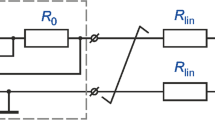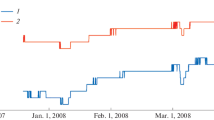Abstract
The most accurate method of digitizing a resistance requires that a bridge be brought to null balance by means of digital steps. Satisfactory circuits of reasonable complexity require irregular electrical dissipation in the sensors, and a relatively wide frequency bandwidth in the detector. This combination places considerably greater demands on sensor quality than do conventional electromechanical recorders, and this has been strikingly confirmed during the initial use at sea of a newly developed digital resistance recorder with a sensitivity of 10−5. Mounted on a coring tool, with miniature outrigger sensors to measure geothermal gradients in the pelagic sediment, the recorder produces sensor readings with considerable scatter even when the sensor probes are buried in sediment. These contrast sharply to the steady reading of the calibration arm. An additional symptom with some sensors is the shunning of certain numbers in the low decades of the digital readings.
The reading scatter varies sharply among different sensor types and can be satisfactorily explained by the production of a high level of white noise when the sensors are biased with excitation current. No adequate explanation has been found for the preferential reading of certain numbers, and it is necessary to speculate about obscure contact effects in those sensors.
Similar content being viewed by others
References
Gerard, R., Langseth, M. G., andEwing, M., 1962,Thermal gradient measurements in the water and bottom sediment of the western Atlantic. J. Geophys. Res., 67, p. 785–803.
Kaye, G. W. C., andLaby, T. H., 1966,Tables of physical and chemical canstants. 13th ed., p. 49, Longmans, London.
Lister, C. R. B., 1963,Geothermal gradient measurement using a deep sea corer. Geophys. J., 7, p. 571–583.
Ratcliffe, E. H., 1960,The thermal conductivity of ocean sediments. J. Geophys. Res., 65, p. 1535–1541.
Author information
Authors and Affiliations
Additional information
Contribution no. 449 from the Department of Occanography, University of Washington.
Rights and permissions
About this article
Cite this article
Lister, C.R.B. Some problems in digital heat-flow measurement. Bull Volcanol 33, 299–310 (1969). https://doi.org/10.1007/BF02596724
Received:
Issue Date:
DOI: https://doi.org/10.1007/BF02596724




